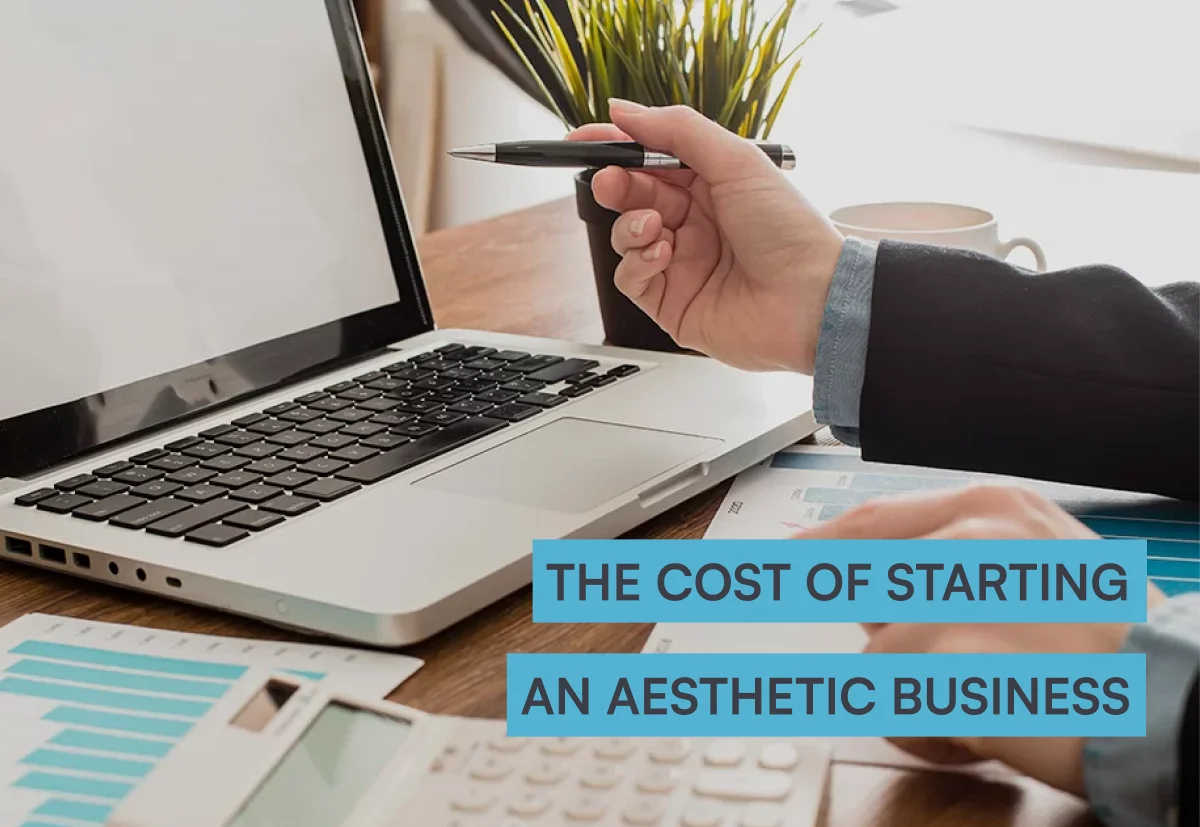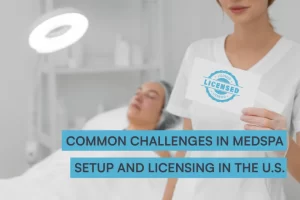Before you can seriously consider opening your own clinic or practice, you’ll need to understand all the costs of starting an aesthetic business… and running one.
Before you can consider setting up on your own and treating new clients, you’ll need to know just how much it’s going to cost you.
How much do you need to have saved? How much will you spend in the first few months? How much will your monthly outgoings be?
You need to know all the costs of starting (and running) an aesthetic business to understand how much you’ll need to make to break even – and to turn a profit.
Without an understanding of costs, you won’t have much chance of success.
So…
Looking to start your own aesthetics business but struggling to understand the costs involved? Download our comprehensive guide to starting an aesthetics business today and learn how to keep costs down while building a successful business.
What does it cost to start your own aesthetic business?
Short answer: It won’t be cheap.
Slightly longer answer: However much you want to spend, depending on your budgets, tastes and ambition.
Financial answer: At least £10,000 on a very tight budget, anywhere up to £40,000 to £50,000, depending on the level of service and experience you want to offer clients.
And that’s just a ballpark estimate for your initial costs and expenditure for the first year.
Of course, those figures are very loose. Some costs, like a company set-up fee or website build are fixed, one-off purchases that won’t vary too much over the next few years. Others, like utilities bills, insurance and supply costs can vary greatly, depending on your usage and requirements.
If you’re already in the medical aesthetics profession (or seriously looking at getting into it), you’ll already have a pretty clear idea about equipment and supply costs.
It’s all the other costs you need to consider too. All the upfront costs you’ll need to put in before you can expect a return on your investment.
All those unforeseen, hidden costs that can quickly mount up if you’re not prepared.
So let’s dig into just what the costs of starting an aesthetic business are.
Understanding the start-up costs for any business
Whether you’re in beauty or medi-aesthetics, golf supplies or event management, when you’re starting your own business there are some universal costs you can expect, regardless of industry.
They include:
1. Company Set Up
If you want to officially set up your new aesthetics business, you’ll need to pay a registration fee with Companies House. It costs £12 if you do it online. That’s if you want to incorporate as a limited company. If you’d rather operate as a sole trader, you don’t need to register. We compare your business set-up options here.
As a limited company, you’ll also need to submit a Confirmation Statement every year. That’s £13 to file online.
And you’ll need to submit your Corporation Tax returns every year. If you’re financially savvy, you could do these yourself. But the chances are you’re not an accounts whizz, and so will probably require the skills of a professional accountant. That will cost you around £600.
You might also want to get a shareholders agreement drawn up, if you’re setting up your business with someone else. This may just require a template, or it might be something an accountant can help with. If it’s complicated, you’ll probably need the support of a lawyer… so budget accordingly.
Anticipated costs: £500-1000 (including accountant fees) for year one.
2. Business Branding
While you might attract a few close friends and family if you start trading as just yourself, to build and grow any successful business, you need a brand. A strong brand identity is the key to attracting clients.
Get it right, and you’ll stand out against all the noise out there, you’ll get straight to the heart of how your prospective clients would like to transform themselves and their lives, and you’ll have them champing at the bit to book an appointment.
It’s worth prioritising branding costs when you start your business, to make sure you get the look and feel of your practice right from the get-go. It’ll save you money on marketing, printed materials, signage and much more.
What you spend is up to you: a logo could cost anywhere from £50 to £5000! You could go source a cheap logo online (and pay for various different versions and files – often a false economy), or you could recruit a world-class designer. You’ll probably land somewhere in the middle.
Just remember a logo on its own is not a brand. You’ll need a tone of voice, a brand personality and key brand messaging if you want a strong, successful brand.
Ask around in your local area for a designer, copywriter and/or brand specialist who can help you… and be sure to check out their work to find styles you like!
Anticipated costs: £300 - £3000
3. Website
Once you have your brand, you’ll want to showcase it online. While you might be tempted to think that a Facebook Business page is enough, a website is essential for any business in today’s connected society; it’s the first place your prospective clients will look for you.
Your start-up costs here will depend on what you’d like your website to do. Would you like a simple, brochure-like site that shows off your practice and your services? A one-pager with just your location listed? Or a fully functional website that allows for client bookings, payments and file sharing?
Before you do anything, you’ll need a web domain/URL address. This will usually be the name of your business. If it’s unregistered (i.e. no-one has claimed it) expect to pay between £1 and £10 for a .co.uk address for the first year and £8 to £20 for a .com address. Previously registered, in-demand URLs will cost you more.
To keep costs down, you could build a website yourself using drag-and-drop site editors like Wix or Squarespace. Or you could ask a designer and/or developer to do one for you. This could cost anywhere between £500 to £5000.
Whichever option you choose, you’ll need to pay for hosting. This is usually between £10 and £30 a month.
Anticipated costs: £120 - £6000
- Then there are the costs of doing business. Those essential purchases that you need to make if you actually want to sell services or products.
4. Supplies
Every business needs supplies of some kind. From basic stationery and computer equipment to the raw materials required to provide your services. For an aesthetics business, product supplies are essential for your treatments, as we cover in the section below.
But for your general business, budget for any technology you need (like laptops, tablets and work phones) and add a little extra for pens, paper, and other typical office supplies.
Anticipated costs: £500 - £2000
5. Utilities
Finally, every business will have some form of utility costs to pay. When setting up your business, these might not be top of your budget list – but many providers ask for set-up fees to be paid, on top of a regular monthly fee/Direct Debit.
If you’re working from home, you might be able to avoid set-up fees, but you could see higher bills for electric and gas… especially given the current energy price rises.
If you’re setting up in new premises, you’ll need to budget for gas, electric, water and internet, at the very least.
Anticipated costs: £300 - £3000 per month
The unavoidable aesthetic business costs
It’s hardly cheap to set up any kind of business, but if you’re starting an aesthetics business, you can expect to have additional costs to plan for too.
As a specialist industry, in a healthcare environment working with the general public, you’ll have costs to pay in a number of different areas. They include:
1. Training and qualifications
The work of an aesthetic practitioner is specialised, it requires training and practice. You’ll need to be confident in your own skills and abilities, and your clients will want to know you have all the relevant qualifications.
Anticipated changes to the law will also mean you must have specific training and qualifications if you want to administer certain treatments like Botox and Dermal Fillers.
But those training courses cost money. Practice sessions, exams and qualification paperwork cost money. The kind of training and qualifications you need to be an aesthetic practitioner will all depend on your current skills and qualifications..
There are several different routes to take, and dozens of training providers to choose from, each offering different courses at a wide range of prices.
Anticipated costs: £2000 - £5000
2. Insurance
Without relevant training and qualifications, your aesthetic business won’t be able to get insurance for your practice. And aesthetic business insurance is absolutely essential.
You’ll need cover for medical malpractice, public liability, products liability and personal accidents. Most cosmetic insurance products will include the above combination, but always check.
You might also need buildings and contents insurance, and additional public liability insurance, if you’re planning on opening your clinic.
There are many different insurance providers to choose from, and any insurance product should be tailored to your specific circumstances, qualifications and the types of treatment you are offering. Expect to pay either monthly or annually.
Anticipated costs: £30 - £150 per month
3. Premises/Mobile
While many companies can operate solely online, an aesthetics business is not one of them. You need face-to-face interaction with clients, which means there will be costs associated with a premises or with a mobile clinic.
These costs are likely to form a substantial chunk of your budget.
You could hire a room in a salon, dental practice or existing clinic, for a set daily or monthly fee. You could rent a floor or building – an entire premises – to set up your own clinic. You might even decide to buy a building outright, rather than pay rental costs every month.
Or you might decide to invest in a mobile clinic option, kitting out your car or van with the necessary health and safety equipment to work in clients’ homes.
(A 4th cost-saving option would be to set up a clinic at home. There are both pros and cons to this. Our free Ultimate Guide To Starting an Aesthetic Business weighs up all the different locations)
The costs of room or building rental will depend entirely on your location. Do you want to establish your practice in a sought-after area with high footfall, or are you happy to take a room in a quieter part of town and encourage clients to drive out to you?
You may also be able to reduce your costs by only paying for space when you’re there – e.g. 2 or 3 days a week, if you’re not planning on working full time.
Anticipated costs: £1000 - £5000 per month
4. Equipment
Next, there are your equipment costs. The specialised machines and tools you’ll need to administer the range of aesthetic treatments that your clients want.
They include:
- A treatment chair/couch
- Worktops
- Rolling tray/trolley
- Sharps/Hazardous waste bins
- Hand washing facilities
- Overhead lights
- Treatment machines (e.g. Laser)
Exactly what you need will depend on the types of treatments you’re offering. It might make financial sense when starting your aesthetics business to offer just one or two core treatments initially – particularly if those don’t require heavy amounts of equipment.
Anticipated costs: £2000 - £6000
5. Product supplies and PPE
Your last essential, unavoided aesthetic business cost will be your actual product supplies. All the consumables you’ll need for your treatments.
This will include:
- Medicines/prescription products, like toxins, dermal fillers, and topical creams
- Disposables like needles, syringes and wipes
- PPE, like gloves, masks and cleaning supplies
The costs of these vary dramatically and will fluctuate based on market value and the supply chain. There are many different stock suppliers, so shop around to find the best value (remember that might not be the lowest cost).
Check for bulk discounts, special offers and shipping costs too.
Anticipated costs: £500 - £2000 + ongoing
Additional purchases you might want to make
All of the above costs we’ve listed are by and large non-negotiable for your new aesthetics business. They’re all the essentials you need to cover if you want a successful practice.
But they’re just the tip of the iceberg.
There are many other areas you will probably want to spend on – the nice to-haves and perhaps even must-haves, depending on your preferences and goals.
You might want:
Extra equipment
If you want to really kit out your clinic or create a comfortable waiting room and relaxing treatment room.
Clinic management software
To help you run your practice smoothly and effectively, taking the hassle out of client bookings, paperwork and payments. Luckily software like Pabau won’t cost you a penny when you’re first starting out.
Extra staff
If you want to maximise your time treating clients, you might want admin support or a receptionist to monitor your front desk, or a nurse to help you with extra treatments.
Marketing
You might find that with the right word-of-mouth exposure and a strong social media effort by yourself (and your close network), that you don’t need to spend on marketing. But more than likely, you’ll want to advertise your new practice in the local area, both on and offline. Setting aside a budget for paid adverts, newspaper posts, roadside posters and paid social media will help boost awareness of your business.
All these additional costs could range from £50 a month to £5000 depending on how far you want to go, and how big you want to grow.
Budgeting upfront aesthetic business costs vs on-going expenses
It’s clear then that you can’t start an aesthetic business on a dime. You’ll need to save up a significant amount of cash and invest it wisely.
You’ll need to manage your costs very carefully to stretch your budget as far as possible.
Make sure you shop around, compare costs and plan out exactly what you need (and what you might be able to live without).
Above all, keep track of your predicted and current spending. A forecast spreadsheet is your best friend.
Remember, all the costs detailed here are rough estimates. Set up a spreadsheet and start gathering real-time prices to forecast all your anticipated costs accurately.
This will give you a true, accurate understanding of aesthetic business costs – both start-up and on-going operating costs.
And when you understand the amount it’ll cost to start your own aesthetics business, and you’re ready to move forward, be sure to check out our Ultimate Guide to discover your next steps. Or head over to our Aesthetic Business Library for more help and advice.




